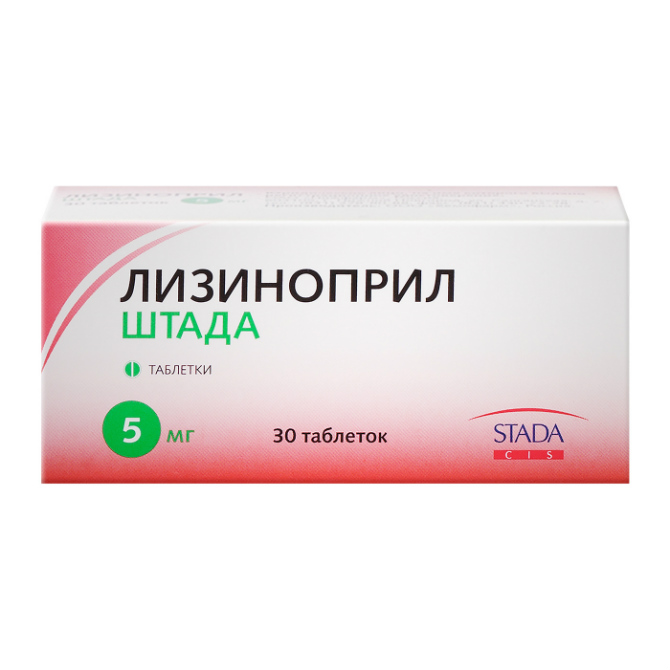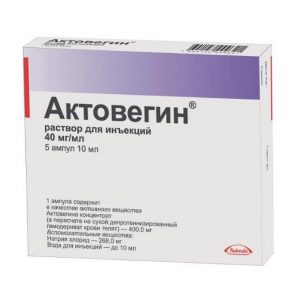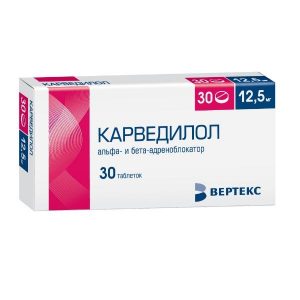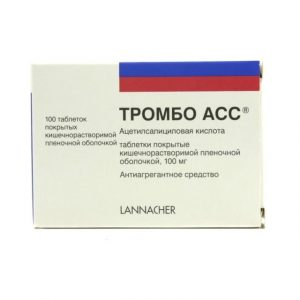Description
Release form
Tablets 5, 10 and 20 mg. On 10 or 30 tablets in a blister strip packaging from a film of polyvinyl chloride and aluminum foil.
2 or 3 blisters for 10 tablets or 1 blister for 30 tablets together with instructions for use in a pack of cardboard.
Packing
30 pcs.
Pharmacological action
ACE inhibitor, reduces the formation of angiotensin II from angiotensin I. A decrease in the content of angiotensin II leads to a direct decrease in the release of aldosterone. Reduces the degradation of bradykinin and increases the synthesis of prostaglandins. Inhibits the tissue renin-angiotensin-aldosterone system, including vascular wall. As a result, blood pressure (BP), total peripheral vascular resistance, preload, pressure in the pulmonary capillaries decrease, the minute blood volume increases, and in patients with chronic heart failure, myocardial tolerance to the load increases. Lisinopril dilates arteries to a greater extent than veins.
The antihypertensive effect begins to develop after 1 hour, reaching a maximum after 6-7 hours, and persists for 24 hours. With arterial hypertension, the effect is observed in the first days of treatment, stable – after 1-2 months. With a sharp withdrawal of the drug, a marked increase in blood pressure is not observed.
Lisinopril reduces albuminuria. In patients with hyperglycemia, it helps normalize the function of damaged glomerular endothelium.
With prolonged use, it leads to the reverse development of myocardial hypertrophy and pathological remodeling in the cardiovascular system, improves endothelial function and blood supply to the ischemic myocardium.
ACE inhibitors increase life expectancy in patients with chronic heart failure, slow the progression of left ventricular dysfunction in patients after myocardial infarction without clinical manifestations of heart failure.
Pharmacokinetics
Absorption from the gastrointestinal tract is 30%. Eating does not affect the absorption of the drug. Bioavailability averages 25-30%. The time to reach maximum plasma concentration (Tmax) is 6-7 hours, in the early post-infarction period – 8-10 hours. The maximum plasma concentration (Cmax) is 90 ng / ml. Lisinopril is not lipophilic and practically does not bind to plasma proteins (less than 5%). Penetration through the blood-brain and placental barrier is weak. Lisinopril is not biotransformed in the body. It is excreted by the kidneys unchanged. The half-life (T1 / 2) is 12 hours. Does not possess cumulative properties. Accumulation in the body is observed only with severe renal failure (creatinine clearance less than 30 ml / min).
In patients with chronic heart failure, absorption and clearance of lisinopril are reduced. Absolute bioavailability is 16%.
In patients with cirrhosis, the bioavailability of lisinopril (by 30%) and its clearance (by 50%) are reduced.
In patients with renal failure (creatinine clearance less than 30 ml / min), the concentration of lisinopril is several times higher than the concentration in the blood plasma of healthy volunteers, the time to reach the maximum plasma concentration and the elimination half-life are increased.
In elderly patients, the concentration of the drug in the blood plasma and the area under the concentration-time curve is 2 times greater than in young patients.
Contraindications
Hypersensitivity to lisinopril and / or other components of the drug, hypersensitivity to other ACE inhibitors, history of angioedema, including those associated with the use of ACE inhibitors, hereditary angioedema, angioedema, and 18 year old idiopathic, idiopathic, idiopathic, idiopathic, and idiopathic, 12 years old efficacy and safety have not been established), pregnancy, lactation, lactase deficiency, galactosemia, glucose-galactose malabsorption syndrome.
Precautions
Stenosis of the aortic orifice, hypertrophic obstructive cardiomyopathy, arterial hypotension, coronary heart disease, coronary insufficiency diet with restriction of salt, hyperkalemia bilateral renal artery stenosis or stenosis of a single kidney artery with progressive azotemia, renal failure after transplantation, renal failure (creatinine clearance less than 30 ml / min), hemodialysis using high-flow dialysis membranes (AN 69 ®) primary hyperaldosteronism cerebrovascular disease, including cerebrovascular insufficiency systemic diseases of the connective tissue (including scleroderma, systemic lupus erythematosus) inhibition of bone marrow hematopoiesis hypovolemic conditions (including as a result of diarrhea, vomiting) old age (over 65 years).
Use during pregnancy and lactation
The use of lisinopril during pregnancy is contraindicated. When pregnancy is established, the drug should be discontinued as soon as possible. Acceptance of ACE inhibitors in the II and III trimester of pregnancy has an adverse effect on the fetus (a pronounced decrease in blood pressure, renal failure, hyperkalemia, skull hypoplasia, intrauterine death are possible). There are no data on the negative effects of the drug on the fetus if used during the first trimester. For newborns and infants who underwent intrauterine exposure to ACE inhibitors, it is recommended to conduct careful monitoring to timely detect a pronounced decrease in blood pressure, oliguria, hyperkalemia.
Lisinopril crosses the placenta. There is no data on the penetration of lisinopril into breast milk. For the period of treatment with the drug, it is necessary to cancel breastfeeding.
Special instructions
Therapy with ACE inhibitors should be started under the control of blood pressure, given the maximum effect of lisinopril after 6-8 hours (with myocardial infarction 8-10 hours). A group of high risk of developing dangerous adverse reactions are patients with heart failure (with or without renal failure). In such cases, treatment with lisinopril should begin under the strict supervision of a doctor in a hospital setting. Similar rules should also be followed when prescribing patients with coronary heart disease, cerebrovascular insufficiency, in which a sharp decrease in blood pressure can lead to myocardial infarction or stroke. Hypotension of the first dose may develop, in particular, in patients with high plasma renin activity (for example, during therapy with high-dose diuretics or congestive heart failure). A pronounced decrease in blood pressure occurs with an initially reduced volume of circulating blood due to diuretic therapy, a low-salt diet, hemodialysis, diarrhea and vomiting. Before starting treatment with lisinopril, it is necessary to replenish the volume of circulating blood and normalize water-electrolyte disturbances. Transient arterial hypotension is not a contraindication for taking the next dose of the drug. When using Lisinopril in some patients with chronic heart failure with normal or low blood pressure, a decrease in blood pressure may be noted, which is not a reason for stopping treatment. With renal artery stenosis (especially with bilateral stenosis, or with stenosis of a single kidney artery), as well as in case of circulatory failure due to a lack of sodium and / or fluid, the use of Lisinopril can lead to an increase in the concentration of urea and creatinine in the blood, impaired renal function, and acute renal failure. Treatment with Lisinopril in acute myocardial infarction is carried out against the background of standard therapy (thrombolytics, acetylsalicylic acid (not more than 300 mg / day), beta-blockers). Compatible with the intravenous administration of nitroglycerin and with the transdermal therapeutic system (TTC) of nitroglycerin. Surgical intervention / general anesthesia. With extensive surgical interventions, as well as with the use of other drugs that cause a decrease in blood pressure, Lisinopril, blocking the formation of angiotensin II, can cause a pronounced unpredictable decrease in blood pressure. Before surgery including dental surgery, the surgeon / anesthetist should be informed of the use of an ACE inhibitor. In elderly patients, the same dose leads to a higher concentration of the drug in blood plasma, therefore, special care is required when determining the dose. Angioedema with the use of ACE inhibitors, including lisinopril, can develop at any stage of treatment. With swelling of the tongue, pharynx, and larynx, obstruction of the respiratory tract with a fatal outcome can develop. If the described complaints appear, stop taking the drug immediately and consult a doctor. In such cases, rapid subcutaneous administration of 0.1% adrenaline solution (0.3 ² 0.5 ml), administration of glucocorticosteroids, antihistamines and / or measures to ensure airway obstruction are necessary. In patients with chronic heart failure, diabetes, while taking potassium supplements, potassium-containing salt substitutes, potassium-sparing diuretics, or other drugs that increase serum potassium ions (heparin), ACE inhibitors increase the risk of hyperkalemia. Taking Lisinopril, like all ACE inhibitors, may be accompanied by a dry cough, which stops when the dose is reduced or treatment is stopped. Since the potential risk of agranulocytosis cannot be ruled out, periodic monitoring of the blood picture is required. In patients taking ACE inhibitors, during desensitization with hymenoptera (bees and wasps) venom, a life-threatening anaphylactoid reaction may occur. It is necessary to temporarily discontinue treatment with an ACE inhibitor before starting a course of desensitization. Anaphylactoid reactions may occur during hemodialysis using high-flow membranes (including AN 69 ®), as well as during apheresis of low density lipoproteins with adsorption on dextran sulfate. Consideration should be given to using a different type of dialysis membrane or other antihypertensive agent. Patients with diabetes require careful monitoring of blood sugar, especially during the first month of Lisinopril therapy. Caution should be exercised when performing physical exercises, in hot weather (the risk of dehydration and an excessive decrease in blood pressure due to a decrease in circulating blood volume). During treatment, it is not recommended to drink alcoholic beverages, since alcohol enhances the hypotensive effect of the drug.
Influence on the ability to drive vehicles and work with mechanisms
There is no data on the effect of lisinopril in therapeutic doses on the ability to drive vehicles and mechanisms. However, it must be borne in mind that dizziness may occur, therefore caution should be exercised.
Composition
1 tablet contains: active substance: lisinopril dihydrate 5.445 mg, 10.89 mg and 21.78 mg (in terms of lisinopril 5 mg, 10 mg and 20 mg, respectively)
excipients: mannitol 12.5 mg / 13.0 mg / 30.0 mg, microcrystalline cellulose 23.255 mg / 25.0 mg / 27.0 mg, ludipress LCE (lactose monohydrate 94.798.3%, povidone 3-4% ) – 60.0 mg / 61.0 mg / 78.02 mg, povidone-K25 – 4.0 mg / 4.5 mg / 6.4 mg, colloidal silicon dioxide 2.5 mg / 3.61 mg / 6 , 0 mg, magnesium stearate 1.3 mg / 1.5 mg / 2.2 mg, croscarmellose sodium 5.0 mg / 5.0 mg / 5.0 mg, calcium hydrogen phosphate 16.0 mg / 25.5 mg / 43.6 mg.
Dosage and administration
Inside, regardless of food intake, once a day in the morning, preferably at the same time.
Dose selection is carried out to achieve the optimal (target level) blood pressure. The maintenance dose is determined depending on the dynamics of blood pressure. Do not increase the dose of the drug earlier than after 2 weeks (accelerated titration of the dose is allowed in patients with asymptomatic left ventricular dysfunction, initial and moderate heart failure, arterial hypertension, and hospitalized patients).
With arterial hypertension, the initial dose is 10 mg / day, the maintenance dose is 20 mg / day, and the maximum daily dose is 40 mg (increasing the dose above 40 mg / day usually does not lead to a further decrease in blood pressure).
Previous diuretic therapy should be discontinued 2-3 days before the start of lisinopril. If it is impossible to cancel diuretics, the initial dose of lisinopril should be no more than 5 mg / day. In this case, after taking the first dose, medical monitoring is recommended for several hours, taking into account the maximum hypotensive effect after 6-7 hours.
In case of renovascular hypertension or other conditions with increased activity of the renin-angiotensin-aldosterone system, the initial dose is 5 mg per day, under strict medical supervision in a hospital (blood pressure monitoring, renal function, serum potassium). A maintenance dose, continuing strict medical supervision, should be determined depending on the dynamics of blood pressure.
With renal failure due to the fact that lisinopril is excreted through the kidneys, the initial dose is determined depending on the creatinine clearance. Further, in accordance with the therapeutic effect and tolerance, a maintenance dose should be established under conditions of frequent monitoring of renal function, serum potassium and sodium.
Creatinine clearance, ml / min
Initial dose, mg / day
30-70 5-10
10-30 2.5-5
less than 10 * 2.5
* including patients on hemodialysis
With persistent hypertension long-term maintenance therapy of 10-15 mg / day is indicated.
In chronic heart failure (simultaneously with diuretics and / or cardiac glycosides) – lisinopril in a dose of 5-10 mg is used for maintenance therapy. The initial dose is 2.5 mg (2.5 mg or 5 mg tablets with risk are used). The maximum daily dose is 20 mg. In case of emergency – increase the dose to 35 mg / day, for a period of at least 2 weeks, under the strict supervision of a doctor in a hospital. If possible, the dose of the diuretic should be reduced 2-3 days before starting lisinopril.
Acute myocardial infarction (as part of combination therapy).
On the first day, lisinopril is indicated only for patients with stable hemodynamic parameters – 5 mg by mouth, then 5 mg after 1 day, 10 mg after two days and then 10 mg once a day. Patients with low systolic blood pressure (100-120 mm Hg. Art.) At the beginning of treatment and during the first 3 days after acute myocardial infarction should receive a dose of no more than 2.5 mg per day.
The course of treatment is at least 6 weeks.
In the event of a decrease in blood pressure (systolic blood pressure is lower than or equal to 100 mm Hg), a daily dose of 5 mg should be temporarily reduced to 2.5 mg.
In the case of a prolonged marked decrease in blood pressure (systolic blood pressure below 90 mm Hg for more than 1 hour), treatment with lisinopril should be discontinued.
For diabetic nephropathy, 10 mg of lisinopril is used once a day. If necessary, the dose can be increased to 20 mg once a day in order to achieve diastolic blood pressure values below 75 mm Hg. in the sitting position for patients with type 2 diabetes mellitus and below 90 mmHg in the sitting position in patients with type 1 diabetes.
Side effects
Side effects are classified by frequency of development: often (1-10%), not often (0.1-1%), rarely (0.01-0.1%), very rarely (less than 0.01 %).
From the cardiovascular system: often – a marked decrease in blood pressure, orthostatic hypotension rarely – palpitations, tachycardia, Raynaud’s syndrome, myocardial infarction, cerebrovascular stroke in patients with an increased risk of the disease.
From the central nervous system: often – dizziness, headache not often – lability of mood, paresthesia, drowsiness / insomnia, rarely – confusion, frequency is not known – depression, fainting.
On the part of the sensory organs: not often – violations of taste and olfactory sensations.
From the respiratory system: often – dry cough is not often – rhinitis is very rare – bronchospasm, sinusitis, allergic alveolitis / eosinophilic pneumonia.
From the digestive system: often – diarrhea, vomiting not often – nausea, abdominal pain, dyspepsia rarely – dry mucous membrane of the oral cavity is very rare – pancreatitis, hepatocellular or cholestatic jaundice, hepatitis, isolated cases of liver failure.
From the urinary system: often – impaired renal function rarely – uremia, acute renal failure is very rare – oliguria, anuria.
From the reproductive system: rarely – decreased potency, gynecomastia.
From the hemopoietic organs: rarely – decrease in hemoglobin and hematocrit very rarely – suppression of bone marrow function, anemia, thrombocytopenia, leukopenia, neutropenia, agranulocytosis, hemolytic anemia, lymphadenopathy.
From the skin: not often – itching is rare – rash, alopecia, psoriasis is very rare – increased sweating, pemphigus.
Allergic reactions: rarely – urticaria, angioedema (face, lips, tongue, larynx or epiglottis, upper and lower extremities) very rarely – toxic epidermal necrolysis, Stevens-Johnson syndrome, erythema multiforme,and positive test results for antinuclear antibodies, eosinophilia, leukocytosis, photosensitivity.
Laboratory indicators: not often – increased concentrations of urea and creatinine, increased activity of “liver” transaminases, rarely hyperkalemia – hyperbilirubinemia, hyponatremia.
Other: not often – increased fatigue, asthenia very rarely – hypoglycemia, autoimmune diseases in some cases – inadequate secretion of antidiuretic hormone.
Drug interaction
Lisinopril can be used simultaneously with beta-blockers, acetylsalicylic acid (not more than 300 mg / day), thrombolytics, nitrates.
With the simultaneous use of lisinopril with potassium-sparing diuretics (spironolactone, triamteren, amiloride), potassium preparations, potassium-containing salt substitutes, cyclosporine, the risk of developing hyperkalemia increases, especially with impaired renal function. Joint use is allowed only with regular monitoring of potassium in the blood and kidney function.
When using lisinopril with other antihypertensive drugs, including diuretics, beta-blockers, slow calcium channel blockers, etc., an additive antihypertensive effect should be taken into account.
The combination of lisinopril with tricyclic antidepressants / antipsychotics, barbiturates, vasodilators, phenothiazines can lead to a marked decrease in blood pressure.
Lisinopril slows down the excretion of lithium preparations, therefore, you should regularly monitor the concentration of lithium in the blood.
Antacids and colestyramine decrease the absorption of lisinopril in the gastrointestinal tract.
The combined use of lisinopril with insulin and hypoglycemic agents for oral administration increases the risk of hypoglycemia, especially during the first month of treatment with an ACE inhibitor.
Nonsteroidal anti-inflammatory drugs, including selective cyclooxygenase-2 inhibitors, estrogens and adrenergic agonists, reduce the antihypertensive effect of lisinopril.
With the simultaneous use of ACE inhibitors and gold preparations for intravenous administration (sodium aurothiomalate), a symptom complex has been described, including facial flushing, nausea, vomiting, and a decrease in blood pressure.
The combined use of lisinopril with selective serotonin reuptake inhibitors can lead to severe hyponatremia and a marked decrease in blood pressure.
Joint use with allopurinol, procainamide, cytostatics can lead to leukopenia.
Ethanol enhances the effect of the drug.
overdose
Symptoms: severe BP, cough, dry mouth, dizziness, anxiety, increased irritability, drowsiness, vascular collapse, respiratory failure, palpitations, palpitations, palpitations, palpitations urination.
Treatment: gastric lavage, absorbents, giving the patient a horizontal position with his legs elevated, intravenous administration of 0.9% sodium chloride solution, vasopressor medicines, blood pressure control, water-electrolyte balance, creatinine, if necessary. With persistent bradycardia – the use of an artificial rhythm driver. Hemodialysis is effective.
Storage conditions
In a dry, dark place and out of reach of children, at a temperature not exceeding 25 ° C.
Shelf life
3 years.
Deystvuyushtee substance
Lisinopril
dosage form
tablets
Possible product names
Lisinopril Stada tablet 5mg N30 (pack control N10x3)
Lisinopril Stada tablet 5 mg, 30 pcs.
LYSINOPRIL-STADA 0.005 N30 TABLES




